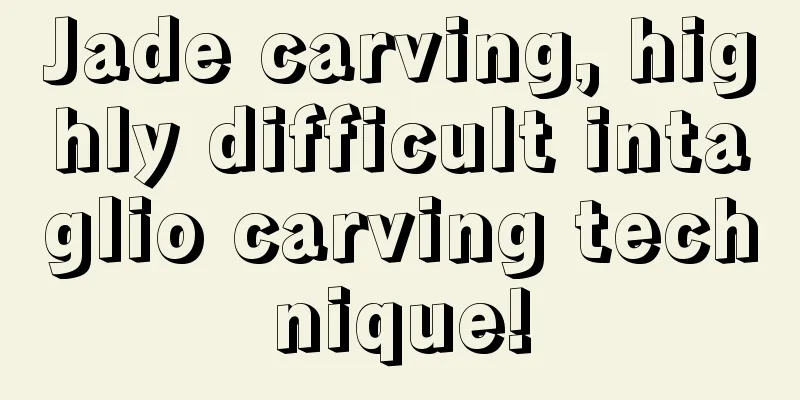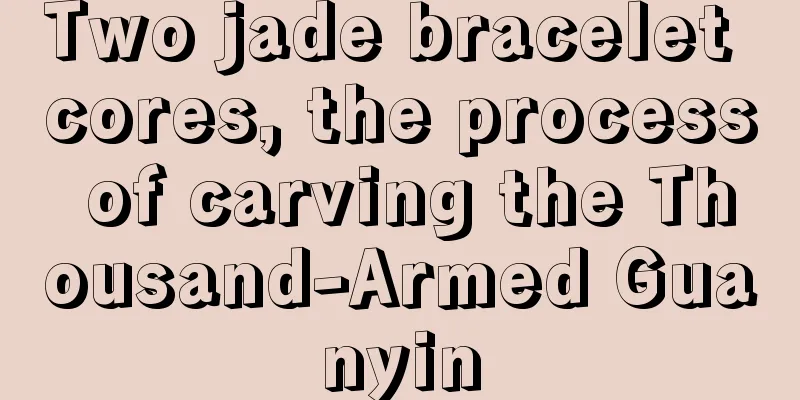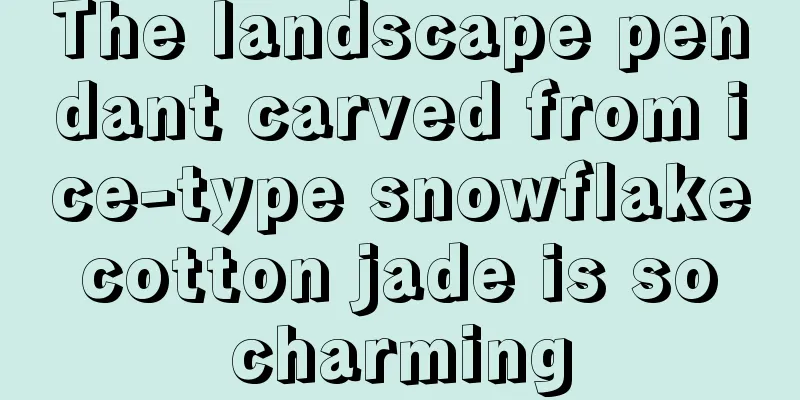Jade carving, highly difficult intaglio carving technique!

|
As the saying goes, jade cannot be made into a useful object without being carved. Every piece of jade must be carved, and carving is a perfect transformation for jade. From a piece of raw stone to the final finished product, it goes through the process of merchants selecting and purchasing materials and the sculptor carefully designing and carving, so there is a saying that "three parts material and seven parts labor". The art of jade carving has developed to the point where various schools have been formed. Some techniques have achieved such an exquisite effect that jade carving is generally divided into two types: manual and machine carving. Compared with machine carving, people prefer hand-carved jade, which is more natural and vivid than machine carving. Common carving techniques include the following: 1. Round carving: a three-dimensional carving 2. Thin relief: a very shallow relief with a sense of painting 3. Line engraving: engraving patterns with single lines. 4. Relief: carving a raised pattern or shape on a flat surface. 5. Intaglio carving: In contrast to relief carving, it is a process of carving a recessed pattern or shape on a flat surface. Also known as Yin carving. 6. Inner carving: It is a jade carving technique that carves round and relief shapes deep into the interior of the jade material. 7. Colorful carving: that is, skillfully using the various colors of jade materials so that the different colors are distributed exactly in the required parts of the jade carving, giving the work a sense of natural harmony. 8. Hollow carving: also known as openwork carving, that is, the carving is not limited to one side of the jade material, but penetrates the jade material and carves out hollows, so that there are many spaces in the jade piece that are connected to both sides. Various types of carving techniques have different requirements. The most common ones on the market are relief, round carving, color carving and hollow carving, while the most difficult one is the negative carving technique. What is Yin Sculpture? Yin carving is a type of carving, also known as sunken carving. It is the art of carving from the back to the inside. The carved painting looks like it is wrapped inside when viewed from the front. Just like writing reverse words on the back, it looks upright from the front. Compared with positive line carving, negative line carving is more difficult and requires emphasis on knife skills and lines. Yin carving requires the sculptor to have a profound foundation in calligraphy and painting. It integrates calligraphy, seal cutting and painting into one, and must be completed in one go. The knife cannot break, no traces of continuation can be left, and it cannot be modified repeatedly. Therefore, you should hold your breath and concentrate when cutting, and move the knife cleanly and neatly. Without long-term practice and contemplation, it would be difficult to do it well. For this reason, only masters with superb skills can make reverse-carved objects look lifelike! Origin of Intaglio The origin of the intaglio carving technique can be traced back to Lithuania a long time ago, but the workmanship at that time was simple and the carving subjects were mostly flowers. Generally, it is carved with blackened amber and then polished on the front to make the overall color have a strong contrast, thus highlighting the theme. Later, this craft was introduced into China and combined with traditional Chinese carving techniques, which greatly improved both the technology and the beauty of the finished products. With the development and progress of the times, the negative carvings created by jade carvers today are even more beautiful. Features of Yin carving The biggest feature of negative carving is that it has a 3D visual effect. The sculptor plays with the pauses and angles of the lines so that when viewed from the front, the lines of the pattern appear dark and dark, giving it a strong three-dimensional feel. The process and time required to make a good jadeite carving is relatively long. If there is any mistake during the process, it is very likely that a good material will be wasted. Therefore, each exquisite Yin-carved jade jewelry is the result of a lot of hard work by the craftsmen. To transform an ordinary raw stone into a beautiful finished product, it requires not only a pair of eyes that can discover beauty, but also a pair of hands that can create beauty. The master sculptor is endowed with a pair of hands of creation by God, bringing many spiritual objects to the world. Whether it is worn or played with, the fun can only be understood, not described. fcgc66 fcpf18 |
<<: To distinguish B and C grade jadeite with naked eyes, just look at these three points
>>: The value and skills of jade carving
Recommend
When it comes to jade carving, do you prefer hand carving or machine carving?
(1) “30% material, 70% workmanship”, there is a l...
These jades are so beautiful!
Jade is a very beautiful stone. Since its prosper...
Investment tips for fine jadeite: what will become the “dark horse” of value-added in the next decade?
Perhaps people over the age of 50 have had the sa...
Why is Jadeite the most valuable among all jades?
Many jade lovers often tell us that after looking...
Secretly teach you how to earn millions of dollars from jadeite collection, maybe one day you will become rich overnight
As the saying goes, "collections are valuabl...
The identification of jade is very important
01 The luster of jade Jade usually has a glassy l...
The jadeite raw stone is full of cracks, but I have no choice but to cut it myself, and cut out jelly-level ice floating flower jadeite
This is a very ugly piece of rough stone. No one ...
The finest blue water jadeite is back in the market, "I can't participate in the world of the rich"!
Blue Water, a type of jade that was forgotten by ...
A piece of ice-green snowflake cotton with cracks all over it, carved out of Guanyin, can be a heirloom
Thousand-armed and Thousand-eyed Guanyin is also ...
When the top-quality jadeite collides with exquisite carving, each piece is eye-opening!
Sharing jadeite raw stones with you every day wil...
Why is the raw material used for inlaying jade in the market K-gold instead of pure gold?
When we buy jadeite, when we encounter inlaid jad...
Jade carving, the art that "lives" on jade!
jade carving The carver carves, the viewer carves...
An article teaches you how to cut jadeite rough stone
No one can tell what is inside an unopened jadeit...
Do different types of jade bracelets have different functions? Let’s take a look together!
Jade bracelets are easy to wear, and wearing the ...
A complete guide to common jadeite purchase questions for novices. It’s not too late to read it now!
As jadeite becomes more and more popular, many ne...









